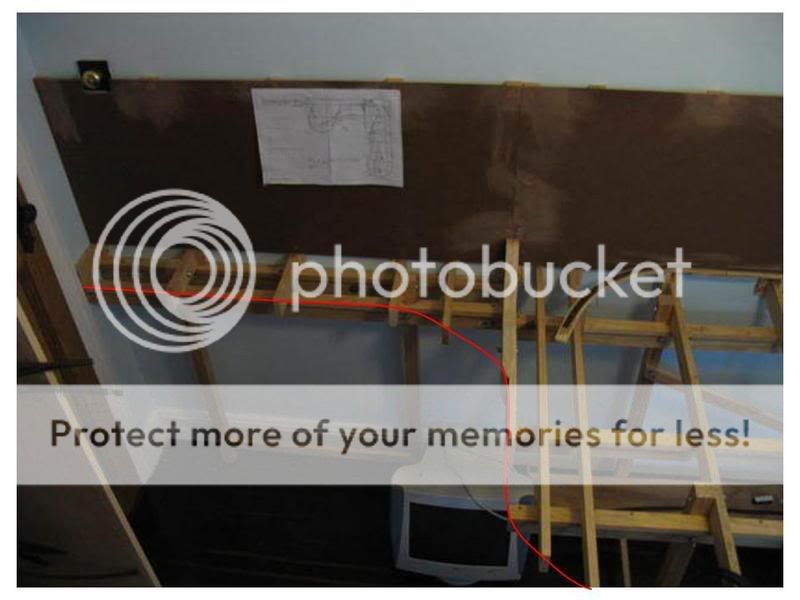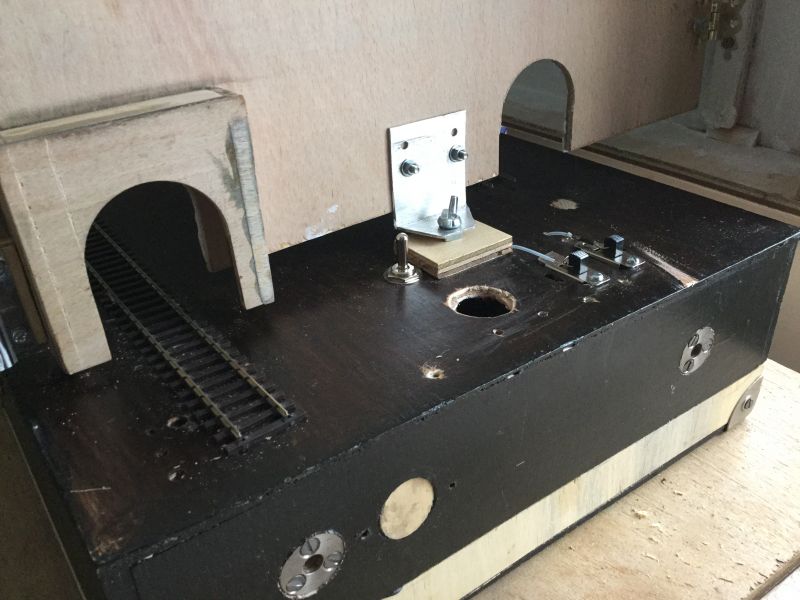Edging
Posted
Guest user
I too like to view and photograph at ground level, and my track is extremely close to the edge. I don't like the perspex getting in the way. So if I ever get around to making a safety barrier it will either be totally removable or possibly built so it can slide up and down, with some swivel pegs to hold it in place when it's up. I couldn't live with something fixed permanently.
Mike
Posted
Full Member
Posted
Full Member
I intend to use plywood as the top for the baseboard, but then I want to overlay that with 1 1/2" to 2" of foam (blue stuff), so I will have an edge that will look somewhat different than all I've read about on this thread so far. I really don't want the edges to show so I will be dreaming up ways to hide it. I also will have trains running dangerously close to the edges.
I have given some thought to this already and came up with an idea to use plasticard (love the stuff) that can be slid up and down vertically (thank you MikeC). By using plasticard I can add depth to it and put grass, dirt, shrubs, trees, whatever on it to make it look like scenery instead of a "Lip".
Wayne
Posted
Full Member
It will be a long while before I actually get around to doing some testing on this mate.
I think that there will be 3 distinct sections of facia.
1. 5mm masonite curved to match the frames of the baseboard. Probably 18" deep and contoured at the top to reflect the landform. (I'm using polystyrene packing foam as in the diorama picture above and I'm happy with the result.)
2. A perspex "sheild" screwed to the Masonite facia rising above the layout height for maybe 6 or 8".
3. Some method of hiding the wiring and underframe, as discussed above, when I get to testing I'll add it to the thread here.
Not much help sorry mate.
Posted
Full Member
………………………………..
I think that there will be 3 distinct sections of facia.
1. 5mm masonite curved to match the frames of the baseboard. Probably 18" deep and ………………………………………….
Marty - you've got my ears wagging !!
I want to add a curve to my layout and really want to make a curved front to the baseboard. How did you do yours ?
'Petermac
Posted
Full Member
Because my layout is L-Girder and joist construction I've just made the joists longer where I wanted the curve to come out into the room.
The masonite facia is flexible, like my backscene and will be screwed to a block on the end of the Joists forcing the masonite to follow the curve.
The original plan for the L-girder framework was created in CAD to allow for even support of the layout and facia.
Hopefully this picture show the concept clearly enough.

I must add that this is the "plan" and I haven't got around to doing the facia yet:oops: :???: but the big US basement layouts use this method and it seems to work for them.
Posted
Full Member
Staying on the thread Kevin.
Posted
Full Member
All modular groups that I am aware of set minimum distances twixt track and edge. Usually 3-4" in HO/ OO. Straight track nearer the edge is usually not an issue, it's points, tight curves, reverse curves, and rail joints on flex track curves that should be avoided. One way around changes in radius is to use set track curves rather than flex track. If it is a fiddle yard who cares what the rail code is? Or whether you have a lip at the edge? (Hinge it or pin and hole it so you can get at any derailed stick). That said errant arms, elbows, shirt cuffs, and jackets are the usual culprits. Plus bodies bumping into the sides.
Make sure the BTB on the rolling stock is correct as well.
My Peco symmetrical 3-way Is good for 3 tracks in a fiddle yard 12" wide, with 1" gaps at the edges, and that is with On30 stock. The asymmetrical one takes too much space.
Nigel
©Nigel C. Phillips
Posted
Full Member

Staying on the thread Kevin.
Posted
Full Member
Well that certainly makes it…interesting. What are the fiddle dimensions?
Nigel
©Nigel C. Phillips
Posted
Full Member
Staying on the thread Kevin.
Posted
Full Member
Interesting as in it is definitely a challenge. Suggestions tomorrow using two turnouts and a wye.
Nigel
©Nigel C. Phillips
Posted
Full Member
 Last edit: by Passed Driver
Last edit: by Passed Driver
Staying on the thread Kevin.
Posted
Full Member
The three way suggestion was made in the basis you had one line in use for fiddling. What you will have (I think) is two tracks in use. The issue you are facing is space, a three way use about 10-12" , and you will need to reverse curve those lines in to the middle, which will take a lot of space if you use 24" radius curves. Even using 18" curves will use a foot or more.
Is the idea to have a train coming out of one side and returning on the other? Having a wye connected to both sides and feeding a three way would be ideal, or two turnouts feeding a wye, but you would end up with about two feet for the storage tracks.
If you have the asymmetrical three way it works best in a central position, not to one side. And it is handed. A double slip would allow interchanging as well.
Nigel
©Nigel C. Phillips
Posted
Full Member
Staying on the thread Kevin.
Posted
Full Member
So just the one line in the left. If you want it central to optimize the space between the track and the edges you may have to put a curve (actually a reverse curve) between the track coming out of the tunnel and the fiddle yard three-way, symmetrical or asymmetrical The actual radius will be dictated by the longest stock you have. Tight reverse curves are susceptible to derailments. You could of course have a simple 18" radius curve with the three way on a diagonal across the yard.
Nigel
©Nigel C. Phillips
Posted
Full Member
Staying on the thread Kevin.
Posted
Full Member
Pencil, piece of string, and a small nail or tack is all you need, unless you have a large compass to hand. Or just use Setrack. Calculating curves and easements (where the curved track radius increases from say 24" to the infinity of tangent track) can get quite complicated. Most people ignore it unless there is lots of room. Stock with bogie wheels is more tolerant of sharp curve to tangent transitions than stock with fixed wheels.
The longest dimension in a rectangle is the diagonal. You would be slightly off that as the incoming track is offset from the corner. Draw two lines, the center and the diagonal, use the compass with your selected radius to see where the three way would start using an S (the reverse curve) for the center line, or a curve for the diagonal. You should get more room using the diagonal. In fact there is no reason why fiddle yards have to be rectangular.
Nigel
©Nigel C. Phillips
Posted
Full Member
Staying on the thread Kevin.
Posted
Full Member
So how much distance do you currently have between the edge of the track coming out of the portal and the edge of the board? Looks about three inches. In which case you might just do it with less than an inch to spare. Not usually considered enough, but if you can live with it goforit. You might be able to get another short 4th track in on the other side with a LH turnout.
Nigel
©Nigel C. Phillips
1 guest and 0 members have just viewed this.

